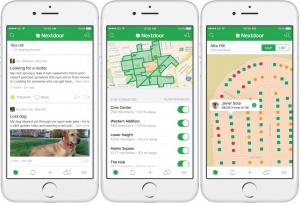Nextdoor
|
Nextdoor is a free social media platform where users can engage and connect with their neighborhood and local community. They have over 210,000 active virtual neighborhoods, which includes nearly 90% of all neighborhoods in the United States. Nextdoor is currently available in the following countries: the United States, the United Kingdom, the Netherlands, Germany, France, Italy, Spain, Australia, Sweden, Denmark, and Canada [1]. These neighborhoods can be as small as 100 households to as large as 3000 households. Some uses of the application include: “finding a last-minute babysitter, planning a local event, or sharing safety tips.”
Contents
History
The company was founded by a group of seven friends in 2008 and has its headquarters in San Francisco, California. The original CEO, Nirav Tolia, resigned in 2018 and appointed Sarah Friar as the new CEO. Nextdoor took a similar approach to Facebook, which was initially restricted by universities, by restricting the network to residents. However, compared to Facebook, users turn to Nextdoor for “its reputation for privacy and a smaller community feel.” The company was valued 1 billion dollars around five years after its creation.
Platform Sections
On the iPhone, Android, iPad, and online application, there are common sections that users can navigate to. The front page consists of a News Feed with Top posts and Recent activity where users have the option to post a message, event, poll, or urgent alert. Below that, there are posts from fellow neighbors from all categories. On another tab, there is a neighborhood map where one can interactively check out the other homes in your neighborhood that also have the Nextdoor application. There are also colors and boundaries on this map to see how involved the neighbor is on the platform. For instance, “green means that a neighbor has signed up at that address” and red means the opposite. Orange means that a neighbor has not signed up, but has been invited by another neighbor. Clicking parts of the map also gives more information on one’s neighbor. Other sections include: Business, For Sale & Free, Local Deals, Events, Real Estate, Crime & Safety, Lost & Found, Documents, and General.
Privacy Policy
Every “neighbor” on the service has to verify their address and members must use their real names to ensure online privacy. There are two ways to verify addresses: phone number and postcard. Nextdoor checks whether one’s mobile phone plan’s billing address matches their address or mails a postcard with a verification code to one’s address[2]. Each neighborhood is also protected with a user’s password and encrypted using HTTPS. Although Nextdoor relies on local and national advertisers to make money, conversations and its directory of names, addresses, and email addresses are not shared with these advertisers. The full privacy policy is transparent and can be found on their website for all customers.
Ethical Implications
Harassment
There have been accounts of cyberbullying on Nextdoor because it is not as well-monitored as other social networking platforms. Nextdoor is also a bigger safety concern because one is required to put their real name and home address[3]. Because neighbors are within close proximity of each other, online threats can lead to unsafe in-person interactions quicker. Public shaming has become quite the trend such as posts that target neighbors for not “watering their lawn enough.[4]” Although Nextdoor means to create neighborly bonds, the service also has the power to destroy them.
Racial Profiling
Nextdoor has a dedicated section called “Crime and Safety.” Unfortunately, many people were concerned that it enabled racial profiling[5]. However, “Nextdoor has tried to eliminate racial bias on the site the same way it built its product: through smart product design...Tolia says the site has cut racial profiling in its crime and safety category by 75 percent.[6]”
Paranoia
The “Crime and Safety” section also has caused many people to feel more unsafe than they should in their own neighborhoods. According to an article in the Chicago Tribune, “people are committing crimes I've never even thought of: casing, lurking, knocking on doors at 11:45 p.m., coating mailbox flaps with glue, "asking people for jumper cables but not actually having a car," lightbulb-stealing, taking photos of homes, being an "unstable female" and "stashing a car in my private garage.[7]"” Nextdoor provides a platform for local communities to be more paranoid than safe.
References
- ↑ Nextdoor. "Where is Nextdoor available?" Retrieved on 29 February 2020.
- ↑ Nextdoor. "Nextdoor Privacy Policy" Retrieved on 29 February 2020.
- ↑ Komando.com "Simple way to protect your privacy on social media sites" Retrieved on 29 February 2020.
- ↑ The Mercury News. "Nextdoor: When a neighborhood website turns unneighborly" Retrieved on 29 February 2020.
- ↑ Buzzfeed News. "Racial Profiling Is Still A Problem On Nextdoor" Retrieved on 29 February 2020.
- ↑ Wired. "For Nextdoor, Eliminating Racism Is No Quick Fix" Retrieved on 29 February 2020.
- ↑ Chicago Tribune. "Nextdoor: Where paranoia lives" Retrieved on 29 February 2020.

